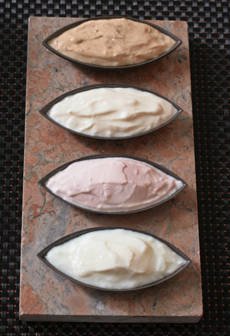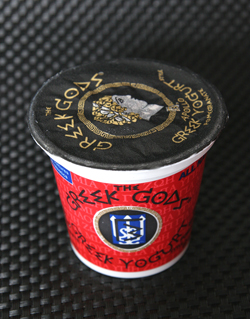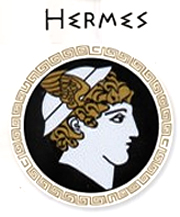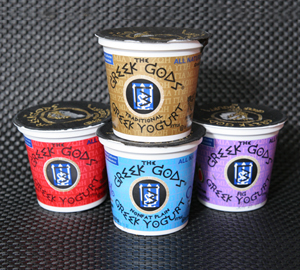

Like ancient Greek sailing ships, The Greek Gods yogurts sail forth. From top to bottom: Fig, Honey, Pomegranate and Plain. All photos by Naheed Choudhry.
July 2007
|
 |
The Greek Gods Gourmet Yogurt
Traditional Greek Yogurt With Probiotics
CAPSULE REPORT: The Greek Gods line of authentic Greek foods was founded in Seattle in 2003. Originally available only in the northwest area, the Greek yogurt line is now available in markets nationwide. The line differentiates itself with the flavors of Greece—fig, honey and pomegranate, with a richer yogurt base that combines cream and milk, and with the addition of probiotic cultures—which will be commonplace soon enough, but are now only in occasional lines. People who eat whole milk yogurt and prefer an elegant, less sweet flavor profile may find something new and enjoyable here.
The Greek Gods, a line of Greek yogurt launched four years ago in Washington state, got a  lot of press for its unusual flavors—but if you were a yogurt lover who lived outside of the Pacific Northwest, you could only hope for the occasion to visit the area. Now, the young company has spread its wings—i.e., its distribution—south and east, and we on the East Coast have gotten to try it. lot of press for its unusual flavors—but if you were a yogurt lover who lived outside of the Pacific Northwest, you could only hope for the occasion to visit the area. Now, the young company has spread its wings—i.e., its distribution—south and east, and we on the East Coast have gotten to try it.
Was it worth the wait? It’s always worth the wait to try something new. We enjoyed tasting the line. It’s rich, smooth and offers flavors we don’t see elsewhere. While we it won’t become part of our regular shopping list (too high-calorie, and we prefer a more flavor-forward style), there are others who, after one taste, may shout eureka!*
*Greek for “I have found it!”
The Difference Between Greek Yogurt and Regular Yogurt
Traditional Greek (or “Greek-style”) yogurt is typically made with cow’s or goat’s milk and differs from “regular” yogurt† in two ways:
†“Regular” yogurt, in which the fruit is already mixed in and distributed evenly throughout, is known as custard, Swiss or French-style yogurt. Yogurt with fruit on the bottom that needs to be mixed in is called sundae yogurt. Learn more in our Glossary of Yogurt Terms.
-
Greek yogurt is a blend of cream and milk, so it has a much higher percentage of milk fat (butterfat)—9% to 10%, compared to regular whole milk yogurts that generally don’t exceed 3.5% milk fat.
-
It is triple strained instead of double strained. The extra straining removes more water from the yogurt, making it more dense, firm and creamy.
There are Greek yogurts available in the U.S. that are made with 2% fat and 0% fat as well as the whole milk and cream version. One of our favorites, FAGE Total Yogurt (currently imported but setting up an American plant), is so rich that the 0% (fat-free) suffices for our needs. Another brand, Liberté Yogurt’s Mediterranée line (imported from Canada), is so wonderfully rich, we enjoy it for dessert, or instead of ice cream. Both of these brands taste much richer than The Greek Gods, which is our way of making the point that, as all American yogurt brands taste different, so will all Greek or Greek-style yogurts. Taste them all to find the one you love.
Flavors
 The Greek Gods yogurt line has a quiet flavor profile. There is a light hand with both the sweeteners (sugar and honey) and other flavorings. Each yogurt has its own Greek god. Regrettably, the packaging only supplies the god’s name and likeness and does not tell the uninitiated what he or she is the god of, and why of all the gods in the Pantheon, he or she was chosen to represent this particular flavor. For example, why did the maiden goddess Artemis (the Roman Diana, goddess of the hunt) get the full-fat Plain Yogurt, but the burly sea god Poseidon get Plain Nonfat (well, maybe that’s the joke)? The Greek Gods yogurt line has a quiet flavor profile. There is a light hand with both the sweeteners (sugar and honey) and other flavorings. Each yogurt has its own Greek god. Regrettably, the packaging only supplies the god’s name and likeness and does not tell the uninitiated what he or she is the god of, and why of all the gods in the Pantheon, he or she was chosen to represent this particular flavor. For example, why did the maiden goddess Artemis (the Roman Diana, goddess of the hunt) get the full-fat Plain Yogurt, but the burly sea god Poseidon get Plain Nonfat (well, maybe that’s the joke)?
At right: Hermes, god of Honey Yogurt.
-
Fig. The most interesting of the choices—how often do you find fig yogurt?—Fig opens to a lovely coffee color with puréed figs on the bottom. Mix it up and you have a subtly figgy yogurt with nutty undertones. We found that adding a packet of our favorite non-caloric sweetener helped to enhance the fig flavor even more, and we enjoyed it not only with breakfast cereals, but the figginess went well with waffles and pancakes. At 270 calories for six ounces, it reminds you that figs are special, but meant to be enjoyed parsimoniously.
-
Honey. This subtly-sweet yogurt is charming. The flavor profile is not distinctively honey—i.e., you wouldn’t know off the top that it is sweetened with honey. It is tasty nevertheless, but there are things we like better for 250 calories.
-
Plain and Nonfat Plain. This yogurt is old-school, puckery-tart, though there is an underlying natural sweetness. We so love the FAGE Total plain yogurt, which is not yogurt-tart but practically sour cream-like, that we didn’t care for these. However, if you’re looking for plain, probiotic yogurt, try them.
-
Pomegranate. Though a pale pink color, it would be hard to say “pomegranate” if someone fed you a spoonful and asked you what flavor it was. Once told, you’d say, “Sure!” Pom is a delicate flavor, so it’s a tough test. The calorie count is 230.
All told, the line is elegant and rich, and offers a set of special flavors not often encountered. The line is preservative-free and produced with rBGH-free milk. It has a yin and a yang: probiotic cultures that provide some health benefits (the brand’s tag line is “Yogurt For A Healthy Life”) but higher fat content (the containers have 15g to 17g of saturated fat, or 25% to 26% of daily value).
Probiotics
The line is enriched with five live and active cultures—S. Thermophilus, L. Bulgaricus, L. Acidophilus, Bifidobacterium and L. Casei. The amount of the active cultures makes The Greek Gods yogurt a probiotic food—it contains “friendly” bacteria to have beneficial effects on the body. Studies show that probiotics help to improve the immune system, reduce cholesterol levels, treat intestinal disorders, protect against allergens, prevent some cancers, lower blood pressure and more. Learn all about probiotic food in our informative article on probiotics.
It may convince you that 270 calories for a fig yogurt is a small price to pay.
THE GREEK GODS TRADITIONAL GREEK YOGURT
Fig, Honey, Nonfat Plain, Plain and
Pomegranate
- 6-Ounce Carton
$1.69 Suggested Retail
Price
Available at fine food stores
including select Whole Foods
Markets.
For more information, visit GreekGodsYogurt.com.
Prices and product availability are verified at publication but are subject to change. |

Pomegranate, Nonfat Plain, Fig, and on top, Honey.
Not shown, Plain. |

|





 lot of press for its unusual flavors—but if you were a yogurt lover who lived outside of the Pacific Northwest, you could only hope for the occasion to visit the area. Now, the young company has spread its wings—i.e., its distribution—south and east, and we on the East Coast have gotten to try it.
lot of press for its unusual flavors—but if you were a yogurt lover who lived outside of the Pacific Northwest, you could only hope for the occasion to visit the area. Now, the young company has spread its wings—i.e., its distribution—south and east, and we on the East Coast have gotten to try it.  The Greek Gods yogurt line has a quiet flavor profile. There is a light hand with both the sweeteners (sugar and honey) and other flavorings. Each yogurt has its own Greek god. Regrettably, the packaging only supplies the god’s name and likeness and does not tell the uninitiated what he or she is the god of, and why of all the gods in the Pantheon, he or she was chosen to represent this particular flavor. For example, why did the maiden goddess Artemis (the Roman Diana, goddess of the hunt) get the full-fat Plain Yogurt, but the burly sea god Poseidon get Plain Nonfat (well, maybe that’s the joke)?
The Greek Gods yogurt line has a quiet flavor profile. There is a light hand with both the sweeteners (sugar and honey) and other flavorings. Each yogurt has its own Greek god. Regrettably, the packaging only supplies the god’s name and likeness and does not tell the uninitiated what he or she is the god of, and why of all the gods in the Pantheon, he or she was chosen to represent this particular flavor. For example, why did the maiden goddess Artemis (the Roman Diana, goddess of the hunt) get the full-fat Plain Yogurt, but the burly sea god Poseidon get Plain Nonfat (well, maybe that’s the joke)?